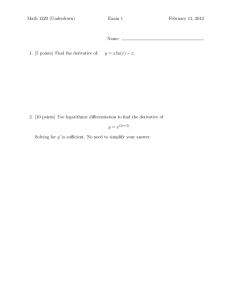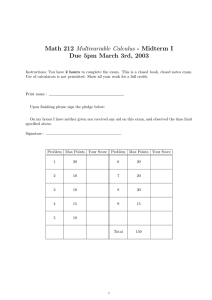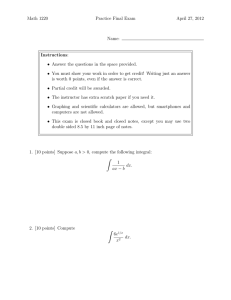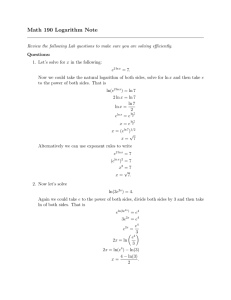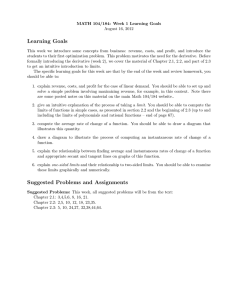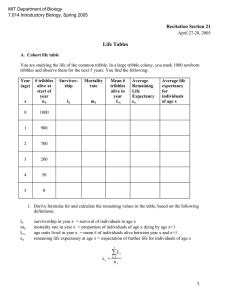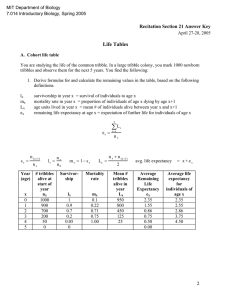Math 1220 (Underdown) Exam 1 February 11, 2012 Name:
advertisement
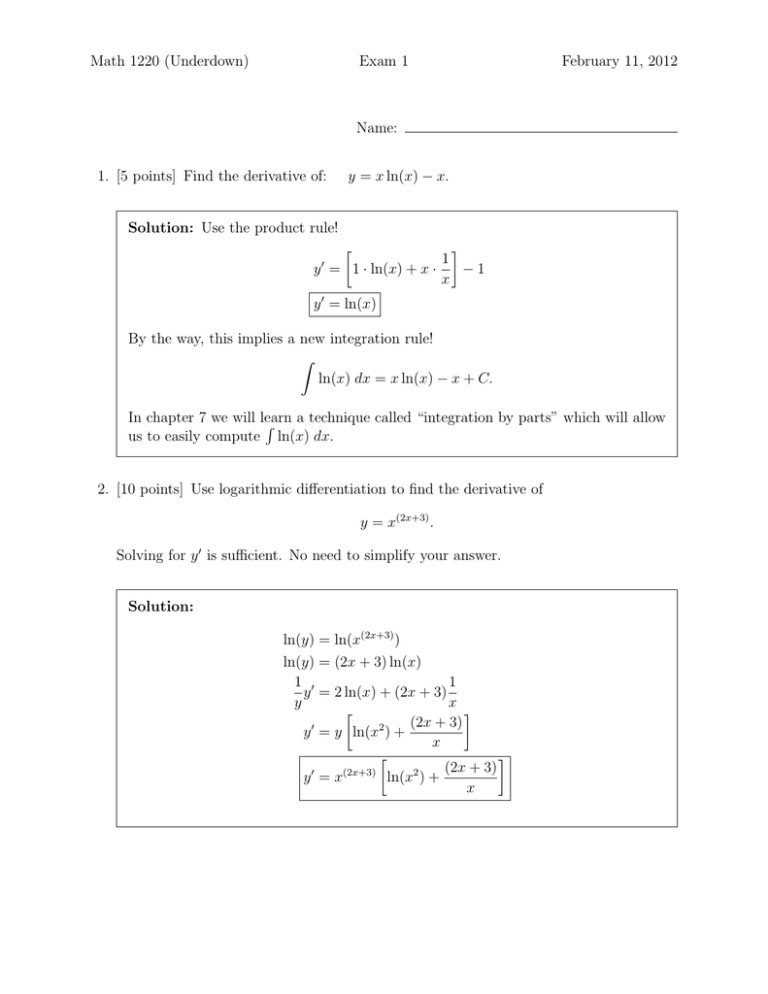
Math 1220 (Underdown) Exam 1 February 11, 2012 Name: 1. [5 points] Find the derivative of: y = x ln(x) − x. Solution: Use the product rule! 1 −1 y = 1 · ln(x) + x · x 0 y 0 = ln(x) By the way, this implies a new integration rule! Z ln(x) dx = x ln(x) − x + C. In chapter 7 we will learn a technique called “integration by parts” which will allow R us to easily compute ln(x) dx. 2. [10 points] Use logarithmic differentiation to find the derivative of y = x(2x+3) . Solving for y 0 is sufficient. No need to simplify your answer. Solution: ln(y) = ln(x(2x+3) ) ln(y) = (2x + 3) ln(x) 1 0 1 y = 2 ln(x) + (2x + 3) y x (2x + 3) 0 2 y = y ln(x ) + x (2x + 3) 0 (2x+3) 2 y =x ln(x ) + x Math 1220 (Underdown) Exam 1, Page 2 of 6 February 11, 2012 Z3 x2 3. [10 points] Evaluate x e − 1 dx. 1 Solution: Notice that exponentiation base e appears in the integrand. When this occurs you should try letting u be the exponent. That is, u = x2 du = 2x dx 1 du = x dx 2 Thus the integral can be written as: Z3 Zx=3 1 2 x ex − 1 dx = (eu − 1) du 2 1 x=1 x=3 Z Zx=3 1 eu du − 1 du = 2 x=1 x=1 ix=3 1h u = e −u 2 x=1 i3 1 h x2 = e − x2 2 1 i 1h 9 = (e − 9) − (e − 1) 2 i 1h = e9 − e − 8 2 Math 1220 (Underdown) Exam 1, Page 3 of 6 February 11, 2012 4. [10 points] Let f (x) = 4x + 5. Compute (f −1 )0 (x) at x = 10. Solution: The “A” student way to solve this is to apply the Inverse Function Theorem which states that when f is differentiable, strictly monotonic (thus invertible) and f 0 (x) 6= 0, then (f −1 )0 (x) = 1/f 0 (x). Since f 0 (x) = 4 and f satisfies the hypothesese of the theorem, we conclude (f −1 )0 (x) = 1/f 0 (x) = 1/4 . You could also just compute f −1 and find its derivative. 5. [10 points] Compute the derivative of y = 3ln x . Solution: Recall that by definition, ax = ex ln(a) . Thus, y = 3ln(x) = eln(x) ln(3) ln(3) y 0 = eln(x) ln(3) · x ln(x) ln(3)3 y0 = x − ln 102 1 . 6. [10 points] Find the value of the expression e Solution: − ln 102 − ln 102 1 2 = e−1 = eln 10 = 102 = 100 e Math 1220 (Underdown) Exam 1, Page 4 of 6 February 11, 2012 7. [15 points] The Trouble with Tribbles Lieutenant Uhura brought two small furry creatures called tribbles onto the starship Enterprise. These adorable pets reproduced very quickly and three days later she counted 54 tribbles! How many days until there are one million tribbles? Assume that the tribble population is governed by: dP = kP. dt You do not need to show how to get the solution to the above model. You may jump right to using the general solution if you know it. If you don’t know it, you can use separation of variables and integration to solve the differential equation, and then use your solution and the data to answer the question. Solution: day 0 3 ? population 2 54 1,000,000 The general solution to this model is P (t) = P0 ekt . The first datum, P (0) = 2 implies P0 = 2, thus our solution is: P (t) = 2ekt . The second datum, P (3) = 54 allows us to compute k: P (t) = 2ekt 54 = 2e3k 27 = e3k ln(27) = 3k (1/3) ln(27) = k k = ln(27(1/3) ) = ln(3). Next we must solve the following for t: 1, 000, 000 = 2ekt 500, 000 = ekt ln(500, 000) = kt ln(500, 000) ≈ 12 t= ln(3) Notice that our population triples or trebles every day because: t P (t) = 2eln(3)t = 2eln(3 ) = 2 · 3t . Thus the trouble with tribbles is that they treble tremendously! Math 1220 (Underdown) Exam 1, Page 5 of 6 February 11, 2012 8. [10 points] A brine tank initially contains 2 lbs of salt thoroughly mixed in 10 gallons of water. The rate of change of salt in the tank is modeled by the equation: 1 dx =4− x. dt t + 10 Use the integrating factor method to solve for x(t), the amount of salt in the tank as a function of time. dx + p(t)x = q(t). Hint: Remember to first put the equation into standard form: dt Solution: dx + dt I=e R p(t) dt =e R 1 t + 10 1 t+10 dt x=4 = eln |t+10| = (t + 10) We can drop the absolute value bars because we are only concerned with positive time, that is t > 0, which implies |t + 10| = t + 10. Z Z d [x · (t + 10)] dt = 4(t + 10) dt dt 2 t x · (t + 10) = 4 + 10t + C 2 C 2t2 + 40t + x= t + 10 t + 10 This is the general solution. The initial condition, x(0) = 2 allows us to solve for the integration constant C, and obtain a particular solution. C 0 + 10 10 C = 20 2= Finally, we have a particular solution: x(t) = 2t2 + 40t 20 + t + 10 t + 10 Math 1220 (Underdown) Exam 1, Page 6 of 6 Question Points Score 1 5 2 10 3 10 4 10 5 10 6 10 7 15 8 10 Total: 80 February 11, 2012
